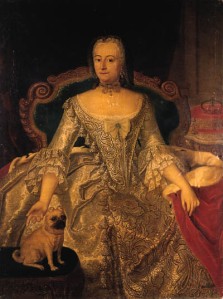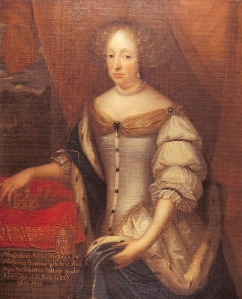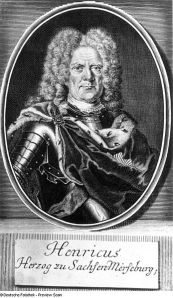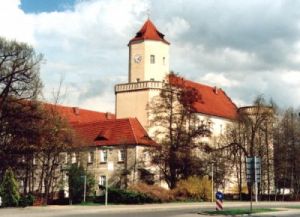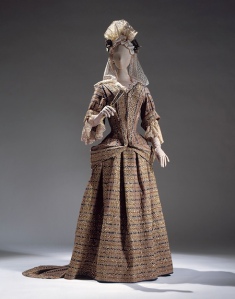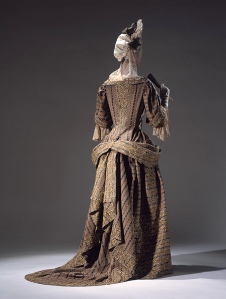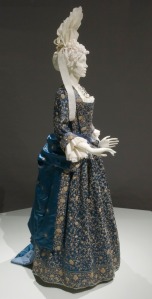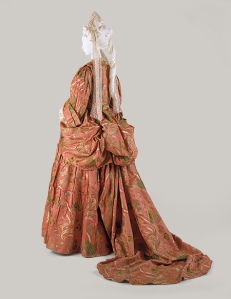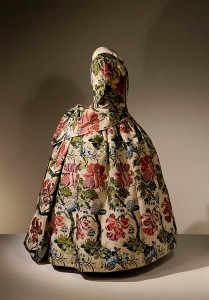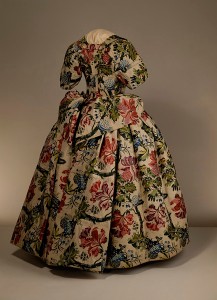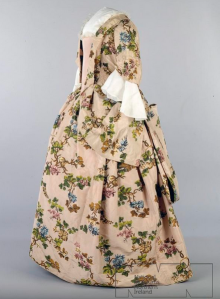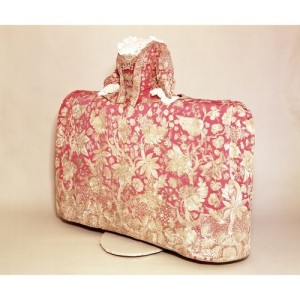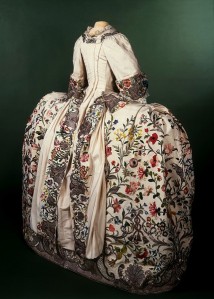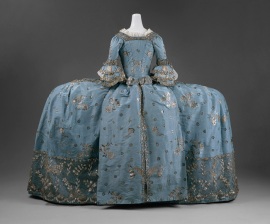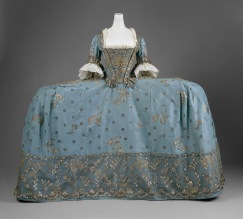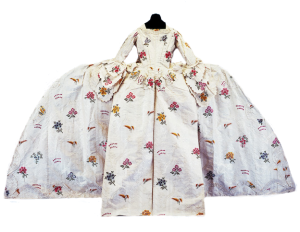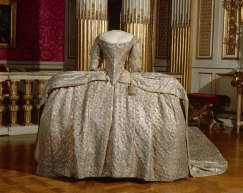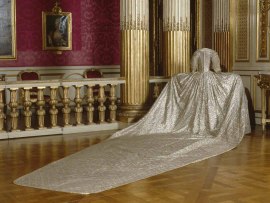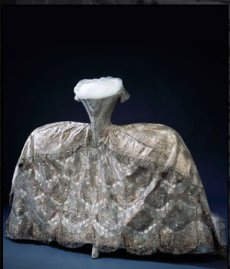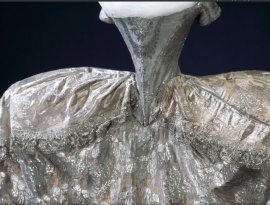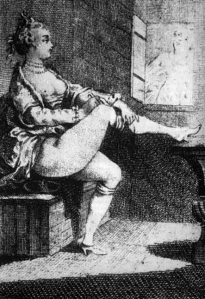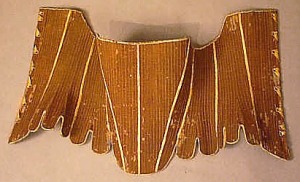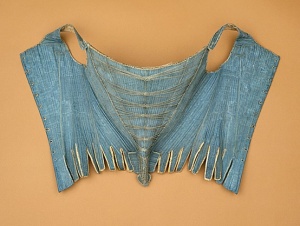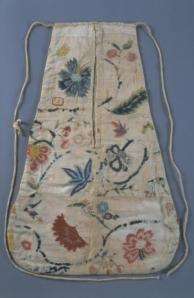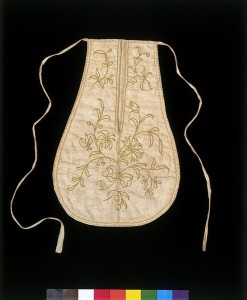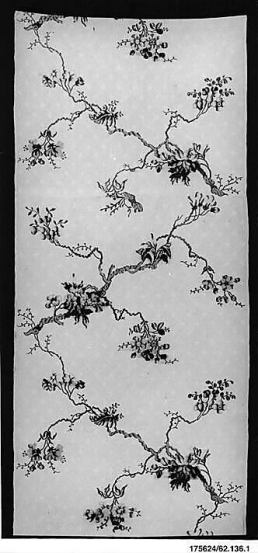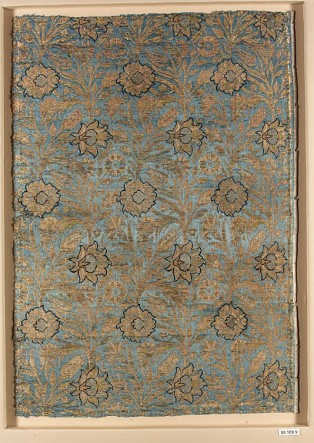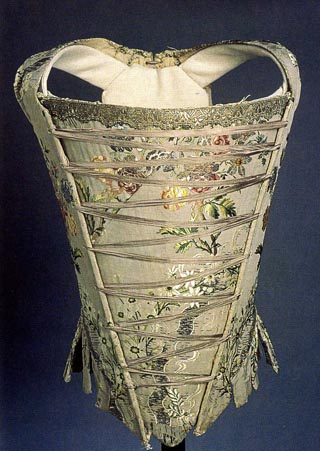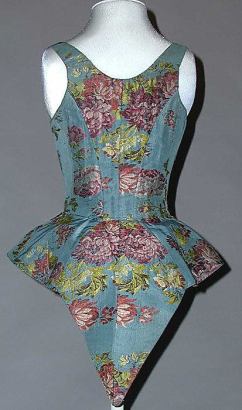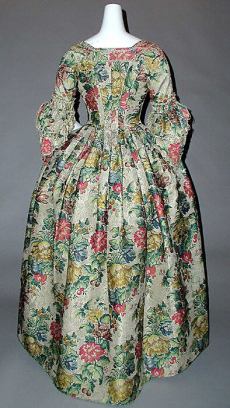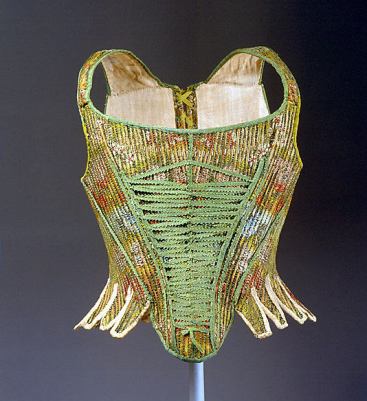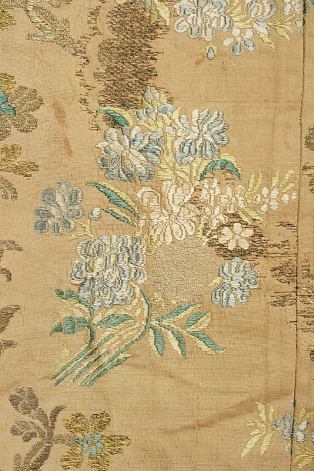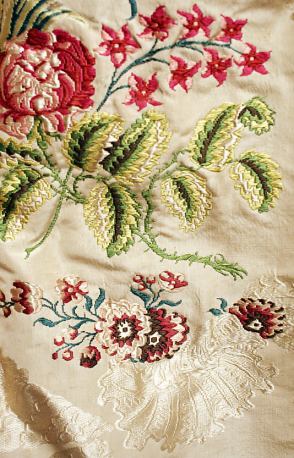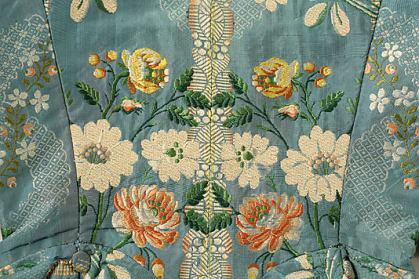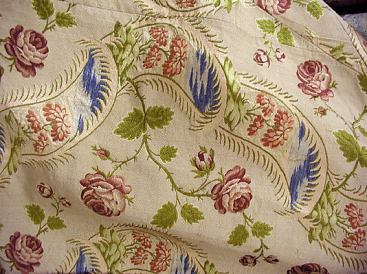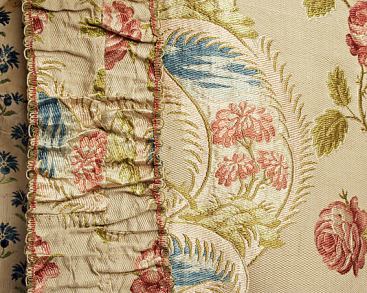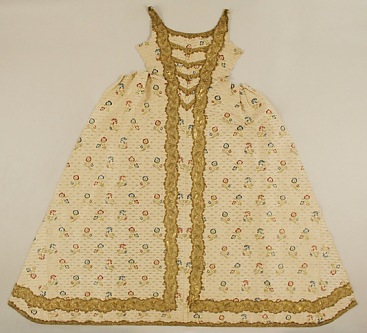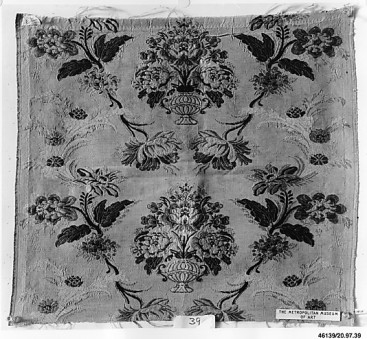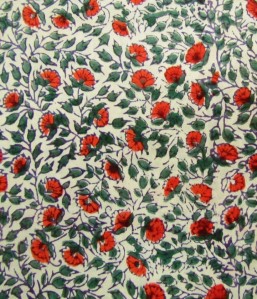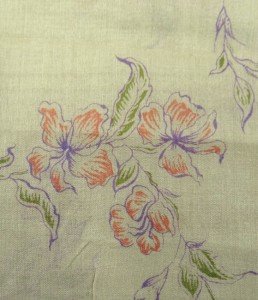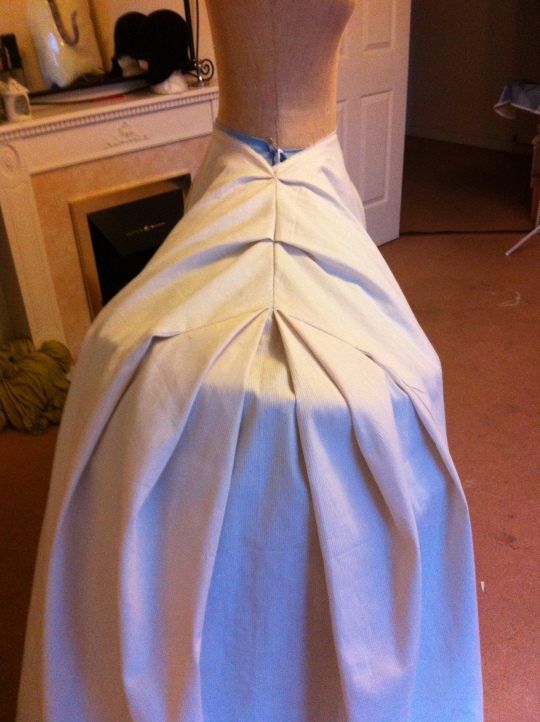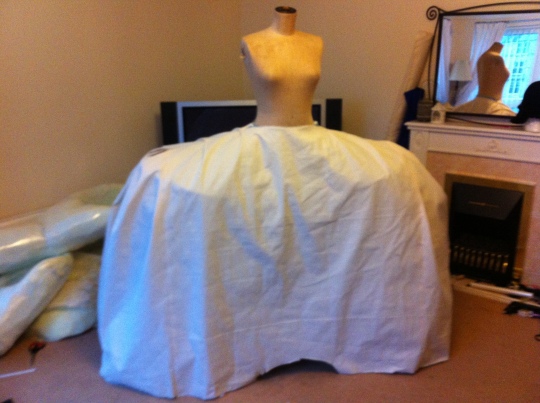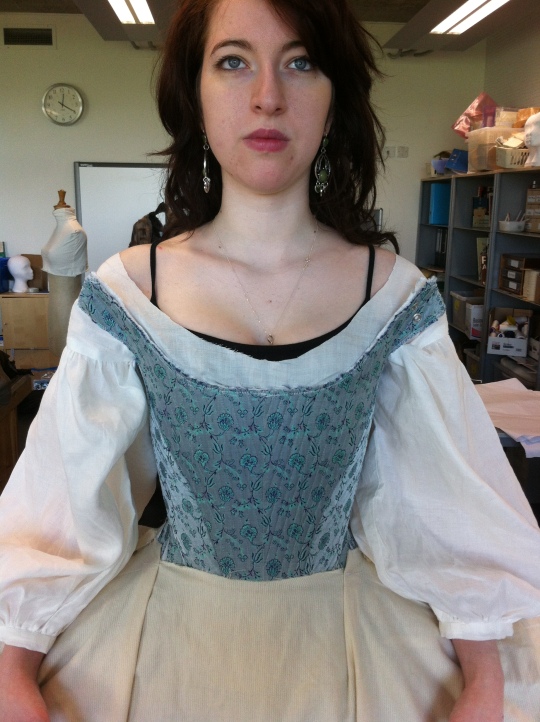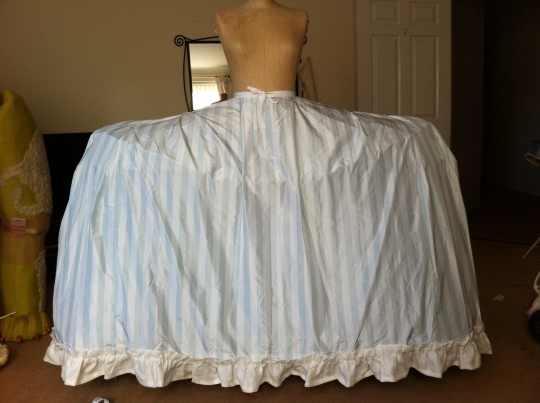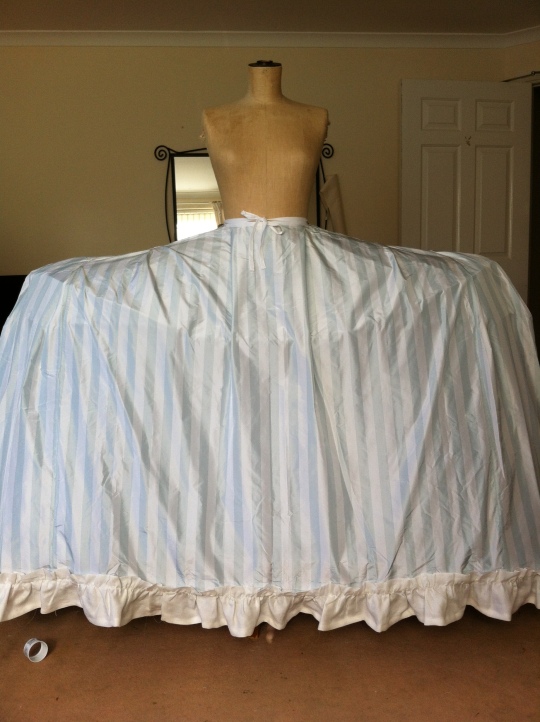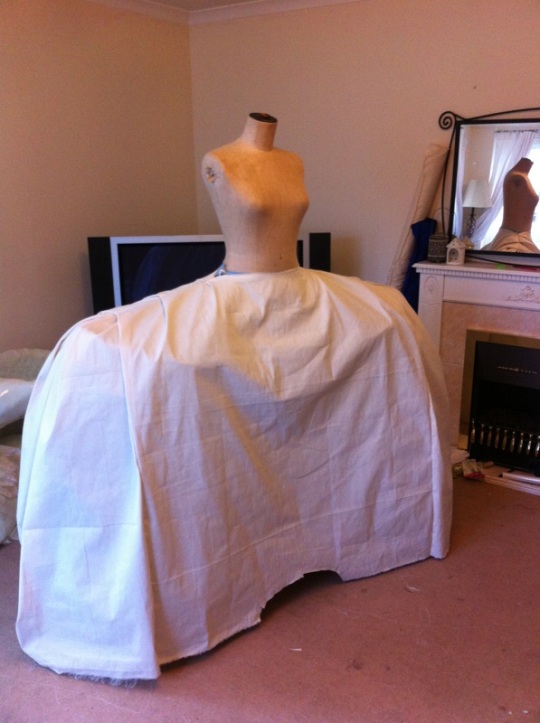For my ISS project I wanted to concentrate on period costume. I want to create a costume as historically accurate as possible so rather than designing my own character costume I would like to choose a historical figure and try to recreate their outfit. I want to look at a period which I haven’t studied before and therefore have chosen women of the 1700’s.
I have briefly looked at a selection of art of the era and would like my chosen portrait to include…
- Panniers – A hooped skirt, the style of which is very distinctive to the 18th century
- Embroidery – I have only ever done snippets of embroidery and would like to take on a larger embroidery project
- Authentic patterns and materials – this will have its limitations but I will try my best
I now need to look closely at portraits and fashions of the period and select a number portraits of historical figures to look into before I make my final decision of the costume I would like to recreate.
Before I headed back to Edinburgh I visited the Victoria and Albert museum in London. They have a lot of examples of embroidery of the period as well as some beautiful court mantua dresses. I have decided to concentrate on goldwork embroidery as my specialist skill for this project, this is a specialist area of embroidery created using metal threads and is featured in many paintings of the 1700’s.
Click on each image for information on its date
I have looked at a lot of paintings from the 1700’s and have picked out a few that have drawn my attention. Some look to complicated and would be pricey to construct but I have included them here anyway. I want to challenge myself this year however. Here are some I have short-listed…
These are some of paintings I came across on my search before I decided I wanted to look at goldwork…

Elisabeth Christine of Prussia by Antoine Pesne early 1750’s

Madame de Saint-Maurice by Joseph Siffred Duplessis 1776

Maria Luisa of Parma by Laurent Pécheux 1765

Marie Rinteau by François Hubert Drouais 1761

Maria Christina Duchess of Sachsen-Teschen by Martin van Meytens

Maria Josepha of Bavaria, artist unknow, circa 1740

Wilhelmine von Bayreuth by Antoine Pesne

Le Bal Paré by Antoine-Jean Duclos 1774
And here are a few that feature goldwork embroidery…

Sophie Marie Gräfin Voss by Antoine Pesne 1746

Augusta of Saxe-Gotha by William Hogarth 1736

Augusta of Saxe-Gotha by Jean-Baptiste van Loo 1742

Maria Amalia of Saxony by Louis de Silvestre 1738

Maria Carolina of Austria by Martin van Meytens

Maria Theresia of Austria by Gabriello Mattei, date unknown

Queen Elisabeth Christine of Prussia by Antoine Pesne 1739

Maria Anna von Sachsen by Georg Desmarées 1765
I have been trailing through hundreds of paintings trying to find ‘the one’ I want to recreate with all of my criteria. Here are a selection of the ones I have found which contain goldwork, some are way to complicated and intricate for my time and budget but I wanted to include them anyway…
Henriette of Brandenburg-Schwedt by Georg Lisiewski 1747




(All above) Maria Theresia 1717-1780

Marie-Josephe d’Autriche by Louis de Silvestre 1719

Duchess Elisabeth Mecklenburgh-Güstrow by ?

Princess Rakoczi by Nicolas de Largillierre around 1720

Anna Korolina Orzelska by Antoine Pesne around 1730

Barbara of Portugal by Jean Ranc around 1735

Friederike Luise of Prussia by ? 1734

Sophia Dorothea Maria of Prussia by Antoine Pesne

Princess Amalia von Preussen by Antoine Pesne

Portrait of Lady Caroline Darcy, Countess of Ancram by Enoch Seeman before 1745

Christine Charlotte von Württemburg-Winnental by Jan Kupecký and Bernhard Vogel 1745

Elisabeth Therese of Lorraine, Queen of Sardinia by ?

Countess Kirstina by Olof Arenius

Madame Adelaide by Jean-Marc Nattier 1756

Friederike of Saxe-Gotha-Altenburg by ? around1750

Princess Maria Teresa, Duchess of Massa and Carrara by Bianca Spina 1750

Portrait of Maria Antonia of Furstenberg by ?

Marquise de Caumont la Force by François Hubert Drouais 1767

Princess Louisa of Stolberg by ? 1772

Maria Francisca Benedita by Miguel António do Amaral 1773
Now I had my brief of 1700’s portraits including goldwork I was on the hunt for a portrait to recreate. After scouring galleries, books and the internet I finally came to a decision. My chosen painting was of Elisabeth von Mecklenburgh-Güstrow 1668 – 1738, artist unknown. I have found very little information about her but have discovered a small amount about her family history…

NAME – Elisabeth of Mecklenburg-Güstrow
BORN – 1668
DIED – 1738
FATHER – Gustav Adolph, Duke of Mecklenburg (26 February 1633 – 6 October 1695)
MOTHER – Magdalene Sibylle of Holstein-Gottorp
MARRIED – Heinrich, Duke of Saxe-Merseburg ( 2 September 1661 – Doberlug, 28 July 1738)
CHILDREN -Maurice (, 29 October 1694 – 11 April 1695)
– Christiana Fredericka (17 May 1697 – 21 August 1722)
– Gustava Magdalena (2 October 1699 – 3 October 1699).
Elisabeth was one of 11 children, 10 girls and one boy. Her father was a Duke and the last ruler of Mecklenburg-Güstrow as his only son predeceased him meaning the end of the Mecklenburg-Güstrow line after his death. His wife, Elisabeths mother, was left widowed with a small court however the family’s glory and significance died out with its last duke. Elisabeth however was not subjected to this degolification as she married Heinrich, Duke of Saxe-Merseburg on the 29 March 1692. Heinrich was regarded as a patron of the arts by his people and had a great love of hunting, he regarded craftsmen highly and commissioned them to build two three-story wings connected with a wooded gallery’s with tented roofs to there summer residency, Schloss Spremberg, an early Baroque castle which started out as a Romanesque tower in 1100. There home is now used as Lower Lusatian Heath Museum, music and art school and the county library.
Elisabeth’s mother Elisabeth’s husband
Schloss Spremberg Castle, Elisabeth’s summer residence
From this information I have collected we now know Elisabeth was a Duchess, she came from a wealthy background and married into one and this is reflected in her clothing. Colour was a status symbol, bright colours were very difficult to achieve with the natural dyes which were all that were available in the 1700’s. The dye of Elisabeth’s deep indigo blue dress would have been shipped over from India and was very popular and fashionable for a while as well as being very costly. Her ermine fur cloak and the metalwork embroidery which contains real silver is another portrayal of high rank and a power dressing statement. Now I have chosen my portrait I can look into fabrics of the era and start ordering my materials.
The most challenging garment to transfer to a paper pattern was the gown. While researching and looking at existing example of garments both first hand in museums such as the V&A, London, and the National museum of Scotland, Edinburgh, at online museum collections e.g. The Metropolitan Museum of Art, New York, which hold a vast assortment of 18th century costume and within reference books I could not find anything that resembles Elisabeth’s gown or many of the other portraits I have looked at. In the portrait her gown appears not to have any seams or joins at the front. This was my first problem as almost every example of a gown I had scene from the 18th century was closed or fastened at the front. My first thought was the dress could have been a Robe à l’Anglaise, these usually closed at the centre front and though it may have been possible that the embroidery was hiding the close, however with further research I concluded the l’anglaise style was not right. Its sleeves are fitted, its neckline slightly square and its bodice plainly decorated. The Robe à l’Anglaise was a development of the Robe à la Française or sacque back gown as it is also known, the main distinctive feature of this gown being the large pleats that hang from the centre back, the development to the Robe à l’Anglaise being that these pleats were stitched down onto the bodice rather than let loose to drape. These are also sometimes named Watteau pleats after the artist Antoine Watteau due to his fascination with painting the dress style. The Robe à la Française was usually worn with a stomacher and had fitted sleeves sometimes flounced cuffs unlike Elisabeth’s dress. Another factor to consider is the dates do not fit. We can judge my her age and style that Elisabeth’s portrait was painted at the beginning of the 18th century whereas the fashions of robes la Française and à l’Anglaise were popular between the 50’s to 80’s.
Countess de Mailly 1698
Met museum late 17th century
I then decided to look further back into history and find out about the styles at the end of the 1600’s in the hope that that would lead me to an answer. I found that the leading style from the 1680’s into the 1700’s was a robe called the Mantua. Elisabeth was alive 1668 to1738 meaning the Mantua was the prominent style for the majority of her adult life. Its first form was a coat-like robe with cuffed elbow length sleeves worn over boned stays with straps and a back lace fastening. Skirt of the robe was open and drawn back over the hips to reveal the gathered petticoats worn underneath. By the 1690’s the top of the mantua was opened and the decorative stomacher panel was introduced
LACMA 1700’s
Met museum 1708
. The style was so popular at this point that dressmakers became known as mantua-makers. The mantua adapted to the changing skirt shapes and was adjusted to be worn over panniers, its draped skirt progressively got smaller until it was only a hanging pleated flap that was swept back over the hips of the panniers.
1709 duchess of burgundy 1730-40
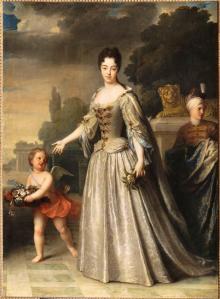
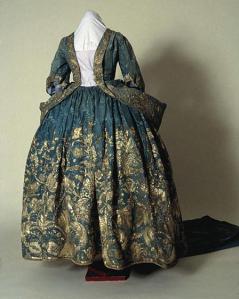
1735-40
1740’s
1740-45
1744
1748-50
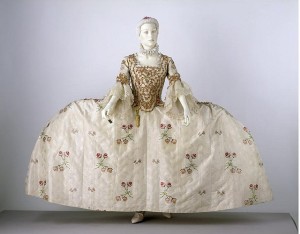
1750
Court-Mantua-Kensington-Palace 1750-1760
1772 Sophia Magdalena of Sweden coronation
Elizabeth Charlotte Holstein-Gottorp wedding dress 1774
The sleeve style of large cuffs and the decorative stomacher of the Mantua matched that of Elisabeth’s garb however there was still the problem of the almost off the shoulder neck line. The majority of portraits I have looked at from the first half of the 18th century all have this feature although none of the existing examples do. Another thing I noticed about early 1700’s portraits is the extreme sloping of the shoulders, after looking in to the history of art at this time I discovered that the elongated slanting and exposure of the shoulders was considered the pinnacle of beauty and femininity at this time. Therefore the gowns stylised appearance when painted was not necessarily what I would have actually looked like in the flesh. This solved my problem of finding a pattern for my dress.
My first priority is the underwear. In the 18th century the ladies silhouette was framed by her underwear. Many garments were worn under the outer clothing, each adding another shape to the silhouette. Here are some examples of ladies at their ‘toilette’ from historical paintings and drawings…
The first layer was the chemise/shift. This has been worn throughout history since the middle ages. The 18th century shift usually came to just below the knee, short enough to be hidden by the petticoats. It was worn to protect the clothes from the unwashed body. Lace often adorned the low cut neckline which peeped out over the stomacher. Flounced lace cuffs draped out from the dress sleeves of upper class women which seemed to be a part of the chemise but these were often detachable for easy of washing. The chemise was usually made from linen or cotton and sometimes had a drawstring neck and sleeves…
Stockings were made of knit, silk or cotton dependant on season and class. They usually came over the knee but tied just below at the narrowest part of the leg. Some paintings of the period depict the stocking tied above the knee however this was only to give the sitter more sexual appeal as this showed more of the leg. They were fixed in place with a ribbon, cord or strap. The upper classes often had richly embroidered stockings.
Stays, now called corsets of the period were almost all fully boned. However versions of stays called jumps were worn by working women and only contained around four bones. Jumps also laced at the front for ease of dressing and had laced straps and sometimes detachable sleeves. Formal stays however moulded the body into the fashionable silhouette; this included a flattened front with the bust pushed high and quite exposed and a synched in waist. Stays with the most support were cut very high at the back and had straps to create perfect posture and support for the bust. Formal stays of the period almost always laced at the back, the women that would wear them would have someone on hand to help lace her in. The majority had tabs at the bottom, the whale bones were taken all the way down into these tabs. This relieved tension from the waist making the corset much more comfortable for the wearer.
Now women carry around handbags to keep hold of their personal item but in the 1700’s women often wore pockets. These where not built into their clothing but were tied separately around the ladies waist over her stays. They were accessible from slits in her skirt, petticoat and side hoops. She would store things like money, jewellery, handkerchiefs, snuff boxes, mirrors and combs, scents and practical items such as needles, scissors and thimbles in her pockets. The contents of them were valuable so ladies often slept with their pockets under there pillows at night. When worn the strings of pockets were often cut and stolen by pickpockets. There is a brilliant a link explaining more about them here https://cawhittaker.wordpress.com/wp-admin/post.php?post=113&action=edit
Hooped skirts have been various shapes throughout history. During the 1700’s side hoops later referred to as panniers became normal attire. At the beginning of the century skirts were worn over domed or bell shaped hoops these began to be extended at the side and flattened at the front and back ending up the familiar style we associate with ladies of the 1700’s. The skirts were first made as one whole structure however they were then split and worn in two side hoops, this style was much easier to walk in however the skirts did get so wide that ladies would have to walk through doorways sideways to accommodate their huge dresses.
Now I have chosen my painting I am going to recreate I want to order my materials. I will be ordering most bits online as I find it to be much much cheaper. Because of postage and requesting samples first this takes some time so I want to order what I can now then can finalize my design and do my technical drawings while im waiting on my fabrics.
I want my costume to be as historically accurate as possible so I have been researching into the fabric types of the era. Obviously there were no artificial fibres so all my fabrics need to be made from natural resources.
Below are some examples of 18th century silks, these sort of silk would have been used for dresses, petticoats stays and shoes…
Printed cottons became very popular in the 1700’s, they were shipped over from India and became extremely sought after. Laws were even introduced in england in 1700 and 1720 to stop the import of Indian chintz (printed cottons) as its popularity meant a fall in the market of English mill produced fabrics. These examples below are modern fabrics that could possibly be used for 18th century chintz garments…
Here are my fabric considerations and choices for each garment...
Chemise/Shift
Elisabeth’s shift or chemise has a been painted with a sheen to it, my first thought was that it was made of silk however I have not found any examples of silk shifts. Chemises have been a staple undergarment throughout history and were nearly always made of linen. Linen is a breathable fabric and therefore well suited for undergarments. The shift was the only garment in the 18th century to be washed regularly, the upper classes would have a clean shift every day. This meant the fabric needed to withstand vigorous washing, linen was well suited to this whereas silk, which tares and damages easily might not even withstand the first wash. The whiteness of the linen was also a noted factor, it was hard to kept the linen white (stark bleached white was unachievable in the 1700’s unlike it is now) as the garment was worn so much and dulled with ware, the whiter you shift, the more wealthy you looked. The fineness of the fabric also attributed to this, finer linen was more expensive and would not stand as many wares or washes as coarser fabric meaning this was also a sign of prosperity. There are examples of shifts with finer linen sleeves than bodies as this was the part of the shift that was on display making the wearer seem better-off than they actually were. Linens were produced in the specific widths of shift bodies. This allowed for no wastage of material, The gussets were cut from the neck hole and the scraps used for cuffs. I have chosen to use slightly off white fine linen for Elisabeth’s shift as she was a woman with money, unfortunately my linen didn’t come in readymade widths however!
My Chosen fabric…
Cotton lace for the cuffs and neckline
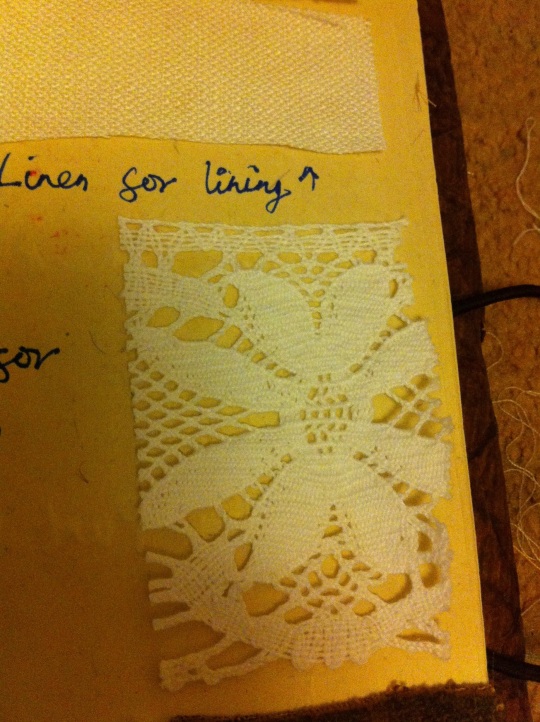 Panniers
Panniers
I have looked at museum websites and most remaining examples of skirt hoops are made from linen however a few I have found are cotton and very occasionally expensive silk. I will most likely use cotton as this is a cheaper to get hold of and I have just ordered a roll of 20 meter medium/heavy weight cotton which should be suitable. The support used in skirt hoops was whalebone (baleen) or cane. However I wont be able to get my hands on either of these! Vena Cava sell a synthetic whalebone which I will use in my stays but I am unsure if will bend in on itself when in panniers especially as I want mine quite large! Instead I will use continuous steel boning which I have used several times before and will keep its shape.
My Chosen fabric…
Medium weight blue linen…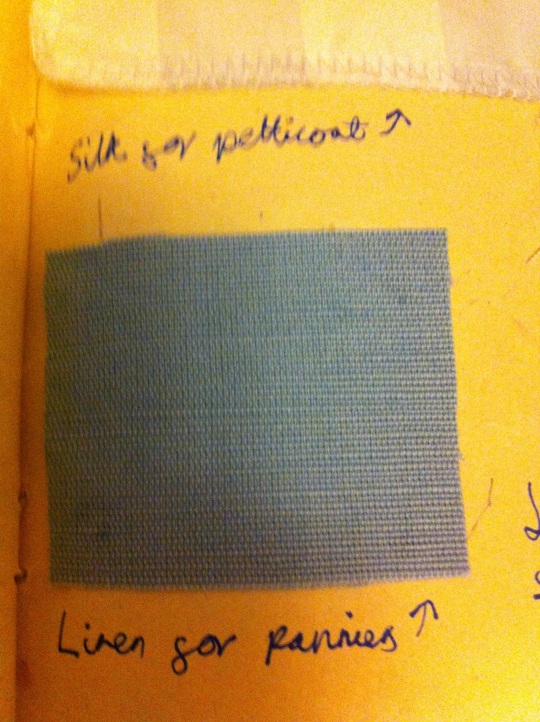
Stays
Stays of the period were made from a number of materials. The outer fabric layer was often silk (which I will be using) but wool or linen were also used. All the stays I have seen of the period are lined with linen, as this is a breathable fabric it was comfortable to wear. The inner layer/s can be canvas, linen buckram or glazed linen. The bones were made from whalebone (baleen), I will be using synthetic whalebone. The stays would have been stitched in linen thread, I have never used this before but will attempt it. Eyelets were hand sewn however due to time I will be cheating and using metal eyelets.
My Chosen fabric…
I bought this silk online but was very green rather than blue so didn’t use it.
Silk brocade…
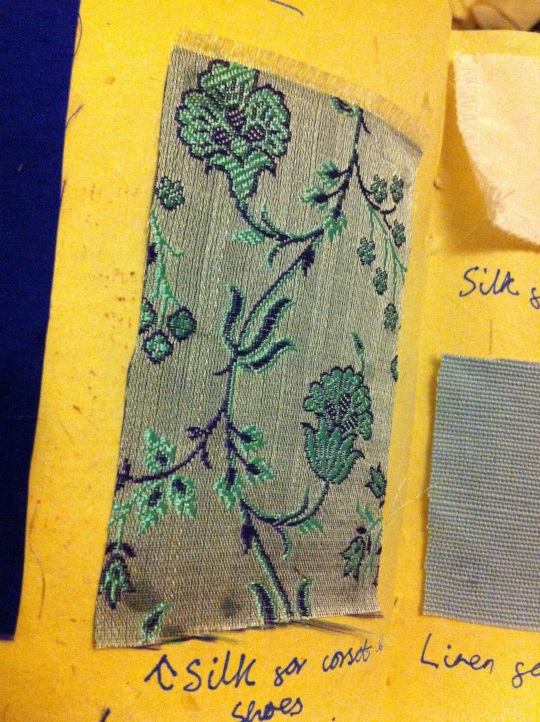
Petticoat
These are needed when skirt hoops are worn to prevent the boning being seen. They were also worn for warmth therefore made from different fabrics depending on the season. Linen, wool, cotton or silk was used. I will make at least one petticoat more if I have time, and will probably use linen.
My Chosen fabric…
Jupe (visible petticoat)
As the jupe petticoat is visible it would have been made of finer fabrics for the higher class lady. I will use a silk in the same fabric as my dress. Quilted petticoats were popular for warmth with informal styles, these became more ornate and decorated meaning they were excepted as more formal wear.
My Chosen fabric…
Indigo silk, the same as the gown…
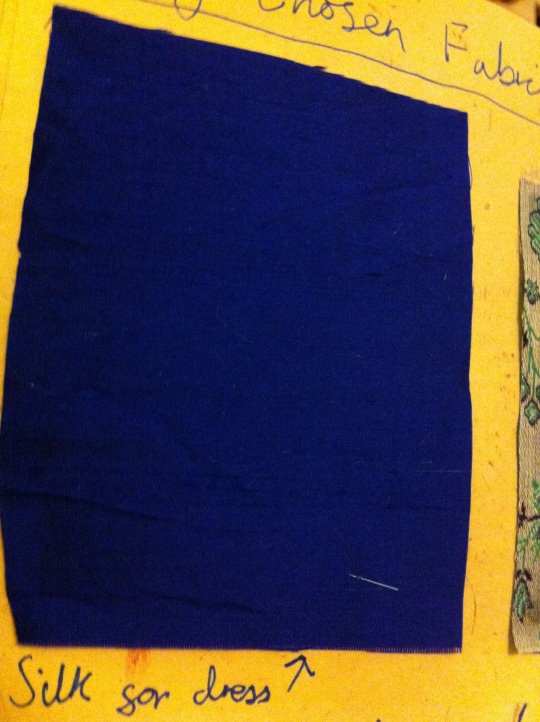
Silver silk used on the reverse as I ran out of blue silk…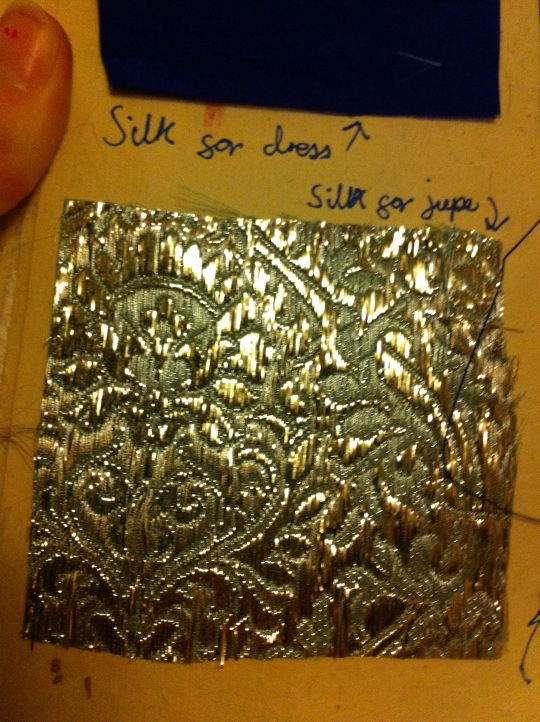
Gown
The majority of robes of this period are of silk however there was a boom in cotton gowns. I will be using a silk, at first I was going to use a dupion as this is a more reasonably priced silk however I did my research and dupion wasn’t really used until the 18th century. I will look for a taffeta that doesn’t break the bank! The lining of the gown was usually linen which I to will use.
My Chosen fabric…
Silver bullion fringe trim…
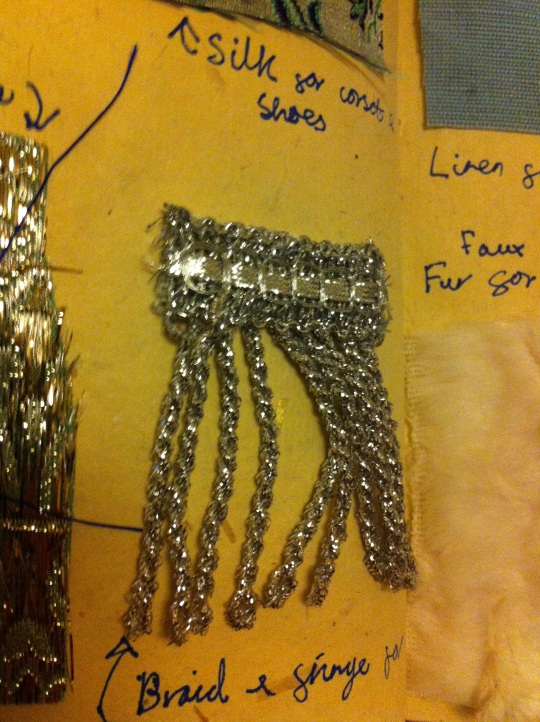 Cloak
Cloak
The cloak with with velvet. The lining would have been ermine but I will obviously have to use faux fur. This is decorated with ermine tails, I will try to find real tails for this but may have to improvise!
My Chosen fabric…
Cotton velvet




































